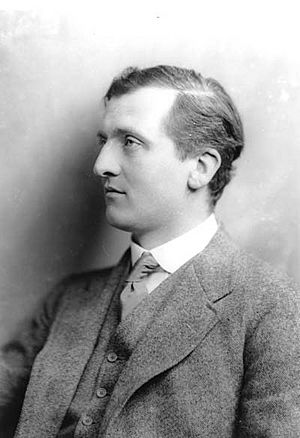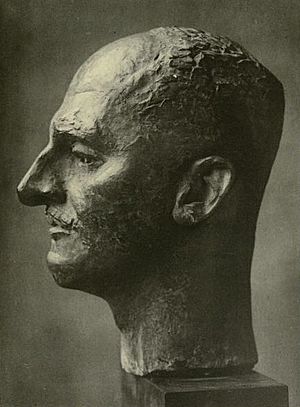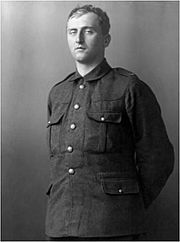T. E. Hulme facts for kids
Quick facts for kids
T. E. Hulme
|
|
|---|---|

T.E. Hulme in 1912
|
|
| Born | Thomas Ernest Hulme 16 September 1883 Endon, Staffordshire, Britain |
| Died | 28 September 1917 (aged 34) Oostduinkerke, West Flanders, Belgium |
| Occupation | Poet, critic |
Thomas Ernest Hulme (/hjuːm/; 16 September 1883 – 28 September 1917) was an English critic and poet who, through his writings on art, literature and politics, had a notable influence upon modernism. He was an aesthetic philosopher and the 'father of imagism'.
Contents
Early life
Hulme was born at Gratton Hall, Endon, Staffordshire, the son of Thomas and Mary Hulme. He was educated at Newcastle-under-Lyme High School and, from 1902, St John's College, Cambridge, where he read mathematics, but was sent down in 1904 after rowdy behaviour on Boat Race night. He was thrown out of Cambridge a second time after a scandal involving a Roedean girl. He returned to his studies at University College London, before travelling around Canada and spending time in Brussels acquiring languages.
Proto-modernist

From about 1907 Hulme became interested in philosophy, translating works by Henri Bergson and sitting in on lectures at Cambridge. He translated Georges Sorel's Reflections on Violence. The most important influences on his thought were Bergson, who asserted that 'human experience is relative, but religious and ethical values are absolute' and, later, Wilhelm Worringer (1881–1965), German art historian and critic – in particular his Abstraktion und Einfühlung (Abstraction and Empathy, 1908). Hulme was influenced by Remy de Gourmont's aristocratic concept of art and his studies of sensibility and style. From 1909 Hulme contributed critical articles to The New Age, edited by A. R. Orage.
Hulme developed an interest in poetry and wrote a small number of poems. He was made secretary of the Poets' Club, attended by such establishment figures as Edmund Gosse and Henry Newbolt. There he encountered Ezra Pound and F. S. Flint. In late 1908 Hulme delivered his paper A Lecture on Modern Poetry to the club. Hulme's poems "Autumn" and "A City Sunset", both published in 1909 in a Poets' Club anthology, have the distinction of being the first Imagist poems. A further five poems were published in The New Age in 1912 as The Complete Poetical Works of T. E. Hulme. Despite this misleading title, Hulme in fact wrote about 25 poems totalling some 260 lines, of which the majority were possibly written between 1908 and 1910. Robert Frost met Hulme in 1913 and was influenced by his ideas. The publisher of the book 'Ripostes' (to which Pound appended the 'complete' poetical works of T. E. Hulme) spoke in that book of Hulme 'the meta-physician, who achieves great rhythmical beauty in curious verse-forms.'
In his critical writings Hulme distinguished between Romanticism, a style informed by a belief in the infinite in man and nature, characterised by Hulme as "spilt religion", and Classicism, a mode of art stressing human finitude, formal restraint, concrete imagery and, in Hulme's words, "dry hardness". Similar views were later expressed by T. S. Eliot. Hulme's ideas had a major effect on Wyndham Lewis (quite literally when they came to blows over Kate Lechmere; Lewis ended the worse for it, hung upside down by the cuffs of his trousers from the railings of Great Ormond Street). He championed the art of Jacob Epstein and David Bomberg, was a friend of Gaudier-Brzeska, and was in on the debut of Lewis's literary magazine BLAST and vorticism.
Hulme's politics were conservative, and he moved further to the right after 1911 as a result of contact with Pierre Lasserre, who was associated with Action Française.
First World War
Hulme volunteered as an artilleryman in 1914 and served with the Honourable Artillery Company and later the Royal Marine Artillery in France and Belgium. He kept up his writing for The New Age. Notable publications during this period for that magazine were "War Notes", written under the pen name "North Staffs", and "A Notebook", which contains some of his most organised critical writing. He was wounded in 1916. Back at the front in 1917, he was killed by a shell at Oostduinkerke near Nieuwpoort, in West Flanders.
[...] On 28 September 1917, four days after his thirty-fourth birthday, Hulme suffered a direct hit from a large shell which literally blew him to pieces. Apparently absorbed in some thought of his own he had failed to hear it coming and remained standing while those around threw themselves flat on the ground. What was left of him was buried in the Military Cemetery at Koksijde, West-Vlaanderen, in Belgium where—no doubt for want of space—he is described simply as 'One of the War poets'."
Works
- Notes on Language and Style (1929, University of Washington Book Store); in The Criterion, Vol. 3, No. 12, (July 1925) (ed. Herbert Read)
- Speculations: Essays on Humanism and the Philosophy of Art (1936, K. Paul, Trench, Trubner & Co., Ltd.), edited by Herbert Read
- Further Speculations of T. E. Hulme (1955, University of Minnesota), edited by Samuel Hynes
- The Collected Writings of T. E. Hulme (1996, OUP), edited by Karen Csengeri
- Selected Writings of T. E. Hulme (2003, Fyfield Books), edited by Patrick McGuinness
Selected poems
- Above the Dock
- Autumn
- A City Sunset
- Conversion
- The Embankment
- Mana Aboda
- The Man in the Crow's Nest
- Susan Ann and Immortality
- The Poet
- A Tall Woman
- A Sudden Secret
- In the Quiet Land
- At Night!
- Town Sky-line
As translator
- Henri Bergson, An Introduction to Metaphysics, (1912)
- Georges Sorel, Reflections on Violence, (1915)
Articles
|
|
|
See also
 In Spanish: T. E. Hulme para niños
In Spanish: T. E. Hulme para niños


